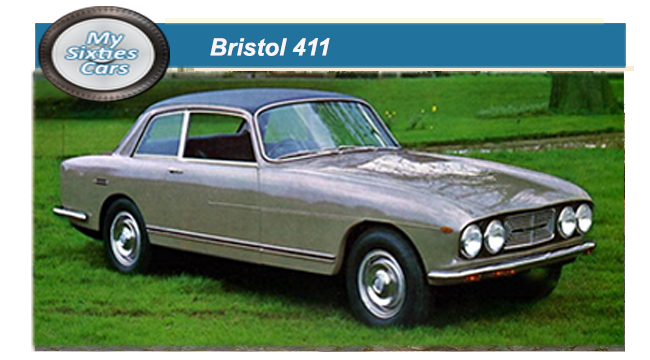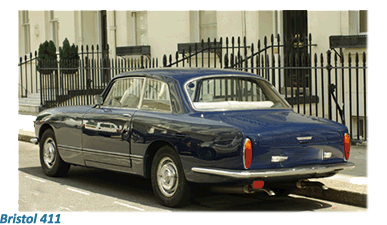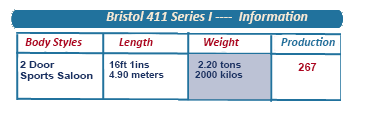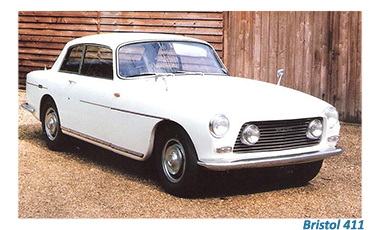
The Bristol 411 Series I released in 1968 was, once again a remodeled version of its predecessor, the 410.
Throughout its eight-year run which saw the launch of five series, the 411 underwent an ongoing but restrained evolvement, driven as much by customer requirements as technological developments and supplier-led change (such as the increase in passenger carrying capacity).
 Restrictive emissions requirements for the US domestic market of the 318 ci unit led to Chrysler convincing Bristol to switch to their more powerful 6277cc 383ci engine, fed by a single four-barrel carburettor which not only boosted power torque but also increased the top speed.
Restrictive emissions requirements for the US domestic market of the 318 ci unit led to Chrysler convincing Bristol to switch to their more powerful 6277cc 383ci engine, fed by a single four-barrel carburettor which not only boosted power torque but also increased the top speed.
According to Bristol, this new injection of power elevated the 411 to 'the fastest true four-seater touring car' on the market at that time.
Although Bristol were among the first UK car manufactures to use it, by the late Sixties, the Torque flite gearbox was the transmission of choice for many of the World’s producers of quality performance cars.
T hanks to its fluid torque converter, the 411’s three-speed unit provided genuinely outstanding performance for shifting the 411's 1.65-ton mass.
hanks to its fluid torque converter, the 411’s three-speed unit provided genuinely outstanding performance for shifting the 411's 1.65-ton mass.
New for the 411 was the fitment of a limited slip differential that enabled more power to be transferred to the w traction in the event of one of the driven wheels slipping- a useful feature on the UK's often wet and windy winding back roads.
Bodywork styling for what was the last of the 400 series continued gently classic styling, which, despite its considerable dimensions, had a relatively low drag coefficient.
![]()
Thinner rounded bumpers protected the front and rear ends, while, in profile, less chrome decorated the flanks.
 The Pegasus statue emblem that had been prominent on the wings of the 410 had been made redundant, replaced by a less attractive but more functional side repeater indicator.
The Pegasus statue emblem that had been prominent on the wings of the 410 had been made redundant, replaced by a less attractive but more functional side repeater indicator.
 Reminiscent of the 406, a single chrome strip disguised the wing storage shut line, while an additional second chrome strip trimmed the back wing. The chrome sill brightwork was also more understated than on the 410.
Reminiscent of the 406, a single chrome strip disguised the wing storage shut line, while an additional second chrome strip trimmed the back wing. The chrome sill brightwork was also more understated than on the 410.
Bristol's typically generous glass area had been subtly restyled too for the 411 Series I, with both the windscreen and rear window being reshaped to be deeper, with a more gradual slope.
Coupled to the thin and unobtrusive 'A' and 'B' pillars, meant that excellent all-around visibility was maintained.
At the rear, the vestigial fins had disappeared, although oval rear-light clusters remained.
![]()
The reshaped tail enabled the opening for the capacious boot to be made more prominent, and thus more convenient for loading the luggage, while a discreet Bristol nameplate adorned the boot lid.
T he 411 Series I’s spacious interior provided ample head- and leg room for four occupants, with Bristol’s marketing material, known to be always slightly over the top, describing as providing all the comfort and appearance of a “ company boardroom “
he 411 Series I’s spacious interior provided ample head- and leg room for four occupants, with Bristol’s marketing material, known to be always slightly over the top, describing as providing all the comfort and appearance of a “ company boardroom “
A minor but significant break in tradition saw Bristol discontinue the two-spoke Bluemels steering wheel that had become a standard, replacing it with a more sporting three-spoke item.
Improvements to the ventilation system, fed by a near-booster fan, helped maintain a fresh environment in the passenger compartment.






